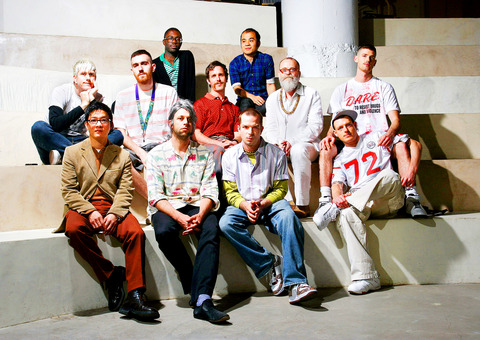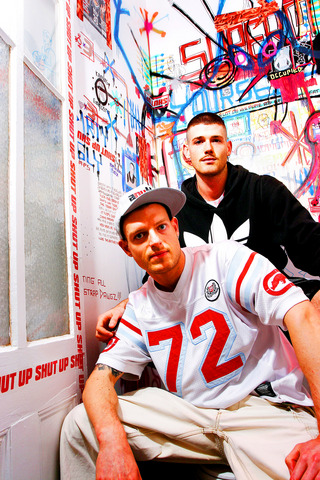Maybe it doesn't signal the arrival of a major arts movement and maybe it is just a symptom of another consumer-driven microtrend, but it would seem that something is afoot in the contemporary art world and it concerns what you could call, for lack of more comprehensive terminology, a burgeoning of gay male art.
You can spot it at galleries like John Connelly Presents or Daniel Reich in Chelsea, or at Peres Projects in Los Angeles, or making a splash in the sales booths at any of the virally replicating international art fairs. It is also, most recently, displayed in The Male Gaze, a just-opened group show at the powerHouse Arena in the Dumbo area of Brooklyn, that makes clear how a new generation of artists is addressing itself frankly to the varied and mutating shapes of sexuality.
Although there are some older artists like Jack Pierson on view at the gallery in Brooklyn, most belong to a generation born in the 1980s and too young to have experienced AIDS' full brunt or the identity politics of that era firsthand. Many, as has been noted by others before, have barely experienced gayness as a threatened condition. Thus they seem to have skipped past self-acceptance and the hoary dramas of the closet, and moved directly to forms of expression that are frank, exuberant, celebratory, bawdy and not infrequently marked by the spirit of juvenilia that the (heterosexual) photographer and filmmaker Larry Clark has been mining for years.

PHOTO: NY TIMES NEWS SERVICE
"The art we're showing," said Nicholas Weist, the curator of The Male Gaze, an assembly of more than 20 mostly young gay artists, among them such collectors' darlings as Christian Holstad, Scott Hug and Michael Magnan, "argues for a new kind of alternativism that reacts against the mainstream of the culture." Not so surprisingly, that includes that expanding part of the mainstream that is gay.
No single art show is a Stonewall, of course, and this burgeoning scene is hardly equivalent to a battle for the cultural ramparts. Yet there are signs that something livelier is at play than some random shows at a select group of galleries.
The most persuasive evidence of this may be the crop of gay art publications that now line the shelves at venerable outposts of culture like the Printed Matter artists' bookstore on 10th Avenue, New York.

PHOTO: NY TIMES NEWS SERVICE
"I've noticed a huge number of little gay periodicals coming out and they're all focused toward the creative end of things," said AA Bronson, the artist and director of Printed Matter, citing publications like Kaiserin, a French magazine "for boys with problems"; Pinups, a coyly elaborate one-image publication by the Brooklyn artist Christopher Schulz; Shoot, the photographer Paul Mpagi Sepuya's autobiographical me-and-my-naked-friends magazine; the provocative Australian zine They Shoot Homos Don't They?; and Daddy, a spray-painted, limited edition production that comes vacuum-packed and with a stylishly tattered customized T-shirt attached.
There are others, from Sweden, Poland and Germany and also hipster outposts throughout Canada and the US. One would list them all if some titles weren't too outright raunchy to be printed here.
This is not to say the magazines are pornographic, although the images they present are often sexually candid. Rather, they, like much of the gay art now being made — and so much art and music and culture of all types — seem to hybridize a generalized fetish for youth culture, for self-exposure, for the small and the intimate and apolitical. They are as solipsistic as a Rufus Wainwright lyric. They are as whimsical as one of the neo-hippie Devendra Banhart's tunes. They have a proudly do-it-yourself aura, but what, these days, does not?
Almost all of the magazines are new, which is to say that their first issues were produced within the past year. And, just as significant, said Bronson, many are among the top sellers among the thousands of titles Printed Matter displays.
"I'm not sure if I'd say what's happening is a movement or a moment," said Vince Aletti, an independent curator and photography critic for the New Yorker, referring to the latest iteration of gay culture. No one does.
Yet, as David Rimanelli, an art critic and longtime contributor to Artforum, said, "There is this huge efflorescence of artists right now doing this kind of work." There are an awful lot of people, gay or otherwise, he added, "making intimate, slightly obscure narratives," of exactly the sort that artists like Hug and Magnan have turned into an a minor industry with K48, their print magazine collaboration with other artists along this loosely federated circuit. Their publication is so polished in its chic, mixtape naivete that each issue comes with an accompanying CD, a fold-out poster and, lately, a back cover advertisement for Dior.
It is probably an exaggeration to say that it all started with Butt, yet it seems obvious that this Dutch gay zine with its trademark pink pages and its aura of 1970s outsider culture provided a template for a passel of imitators.
"I adore Butt," said Bruce Hainley, a critic and curator who is the associate director of criticism and theory in the graduate program at the Art Center College of Design in Pasadena, California. Its publishers, Gert Jonkers and Jop van Bennekom, Hainley added, "are clearly aware of an After Dark, Andy Warhol's Interview, 1970s GQ gay aesthetic, but are not beholden to nostalgia."
Still, nostalgia remains a powerful current running through the new gay male art scene, manifest as a longing for what, from a distance, looks like the utopian days of radical and pre-AIDS politics and unfettered sex.
That many gay people now find themselves squarely in the mainstream is a source of useful friction for artists like Dean Sameshima, whose Web site explains that his randy autobiographical work was inspired by "the will to assert and examine the continued existence" of underground gay cultures. A similar thought turned up a while back in a Butt interview with the gay German playwright Patrick Schuckmann.
"Gay culture is coming to an end," said Schuckmann, head writer for a hugely popular German soap opera whose title, translated, is Good Times, Bad Times. "In a way I regret that, because this gay identification was so important for me, and I liked the revolutionary aspects of this idea of having a different sexuality. Now it's all about marriage and being like everybody else."
Well, it is unless it is not.
"It's important to be gay and be out, of course, to be who you are," said James Morrison, a 29-year-old artist whose piece in The Male Gaze is called Friendster Is Dead. "But I think we're moving into this next generation of art where being gay comes secondary."
For Friendster Is Dead, Morrison made drawings of his friends from the online social network and reproduced them on adhesive stickers that cover a column in the gallery's main space. Although the images at first seem interchangeable and generic, they are actually coded to signify the status of each relationship. Platonic pals are signified with gold or silver stickers; friends with benefits, representing people with whom Morrison has had sexual encounters, are outlined in pink. Black graphite is used for acquaintances. Upside-down drawings, Morrison explained, represent people who have "de-Friendstered" him.
"With this piece, there's a gay tendency, I guess, because you realize that all the people I've had sex with were men," said Morrison, although were it not for the show's title one would hardly pick out this detail.
"It's all very depoliticized, which is OK," as Rimanelli said, referring to the new gay art. Since the personal used to be thought of as the political, he added, it could be that the absence of polemics and big statements is precisely the point.
As a Benetton-style tag line for the Swedish zine Loyal reads, there are "many colors in the homo rainbow." That may not be entirely the case, although the art world in general has become more inclusive of late. Yet the breadth of representation in The Male Gaze and the bumper crop of new gay publications suggest there is, at the very least, a broad and welcome dispersion.
"Gay culture has been more and more exposed, but what is it?" asked the artist Qing Liu, whose wall installations at The Male Gaze drolly rewrite tabloid headlines and entertainment gossip to alter the news in ways that might once have been thought of as "queering" the text.
"I am Qing Liu — Asian and queer, poor and artist, and many other things," Liu said. "Everything others claim I am entitles me to a question. And the one question I have been working constantly to raise is, What exactly is gay now?"

On April 26, The Lancet published a letter from two doctors at Taichung-based China Medical University Hospital (CMUH) warning that “Taiwan’s Health Care System is on the Brink of Collapse.” The authors said that “Years of policy inaction and mismanagement of resources have led to the National Health Insurance system operating under unsustainable conditions.” The pushback was immediate. Errors in the paper were quickly identified and publicized, to discredit the authors (the hospital apologized). CNA reported that CMUH said the letter described Taiwan in 2021 as having 62 nurses per 10,000 people, when the correct number was 78 nurses per 10,000

May 5 to May 11 What started out as friction between Taiwanese students at Taichung First High School and a Japanese head cook escalated dramatically over the first two weeks of May 1927. It began on April 30 when the cook’s wife knew that lotus starch used in that night’s dinner had rat feces in it, but failed to inform staff until the meal was already prepared. The students believed that her silence was intentional, and filed a complaint. The school’s Japanese administrators sided with the cook’s family, dismissing the students as troublemakers and clamping down on their freedoms — with

As Donald Trump’s executive order in March led to the shuttering of Voice of America (VOA) — the global broadcaster whose roots date back to the fight against Nazi propaganda — he quickly attracted support from figures not used to aligning themselves with any US administration. Trump had ordered the US Agency for Global Media, the federal agency that funds VOA and other groups promoting independent journalism overseas, to be “eliminated to the maximum extent consistent with applicable law.” The decision suddenly halted programming in 49 languages to more than 425 million people. In Moscow, Margarita Simonyan, the hardline editor-in-chief of the

Six weeks before I embarked on a research mission in Kyoto, I was sitting alone at a bar counter in Melbourne. Next to me, a woman was bragging loudly to a friend: She, too, was heading to Kyoto, I quickly discerned. Except her trip was in four months. And she’d just pulled an all-nighter booking restaurant reservations. As I snooped on the conversation, I broke out in a sweat, panicking because I’d yet to secure a single table. Then I remembered: Eating well in Japan is absolutely not something to lose sleep over. It’s true that the best-known institutions book up faster